Over time, most of us post hundreds—or even thousands—of tweets. Some are throwaway thoughts, others are detailed threads, links, or images that once sparked engagement.
But later, when you want to:
🛠 Audit your old posts (delete irrelevant ones, or clean up your history),
📊 Analyze what worked best in terms of engagement,
🔁 Repurpose older threads into blog posts, LinkedIn content, or newsletters,
🗃 Archive everything for safekeeping or compliance,
…you’ll quickly realize that Twitter/X doesn’t give you an easy way to export tweets into a clean, structured file.
Yes, Twitter lets you request a full account archive, but it’s bulky, takes hours or days to prepare, and isn’t structured for easy analysis. And if you want to export someone else’s public tweets—competitors, influencers, or peers—Twitter doesn’t let you at all.
That’s where export tools and browser extensions come in. These services allow you to pull tweets into CSV or Excel files with useful metadata, making your content analyzable, searchable, and actionable.

Why Exporting Tweets is So Valuable
Most people think of exports as backups. But exporting tweets can do much more than that:
➡️ Content Audit: You might have thousands of old tweets cluttering your profile. Exporting lets you scan them in bulk and decide which to delete, which to keep, and which to resurface.
➡️ Competitor Research: Export a competitor’s tweets to see what they talk about most, which hashtags they lean on, and which types of posts earn them the highest engagement.
➡️ Performance Analysis: Load your exported tweets into Excel or Google Sheets to analyze likes, retweets, replies, and impressions over time. Spot patterns, like: do images perform better than text? Do threads outperform single tweets?
➡️ Content Repurposing: Some of your best tweets can live again as LinkedIn updates, Instagram captions, or even part of an email campaign. Exporting helps you quickly find your top content without scrolling endlessly.
➡️ Archival & Compliance: If your account ever gets suspended or hacked, you’ll still have a local backup of your tweets. For journalists, researchers, or businesses, this can be a compliance necessity.
Safety and Trust: What to Watch Out For
Not all tools are safe. Many Chrome extensions work by scraping tweets directly from the web interface, which:
- Can trigger account locks or suspensions if Twitter detects unusual activity.
- Might only capture partial data (missing media or engagement stats).
- Sometimes request permissions beyond what they need, raising privacy risks.

Best Tools to Export Tweets (2025 Edition)
There are many extensions and tools floating around, but only a few are reliable enough for exporting tweets in a way that’s both useful and safe. Here’s a closer look at the ones worth knowing in 2025:
1. Circleboom Twitter (⭐ Recommended — Official Partner)

⭐ Rating: 5.0
If you only try one tool from this list, it should be Circleboom. Unlike almost every other export extension out there, Circleboom is an official partner of Twitter/X.
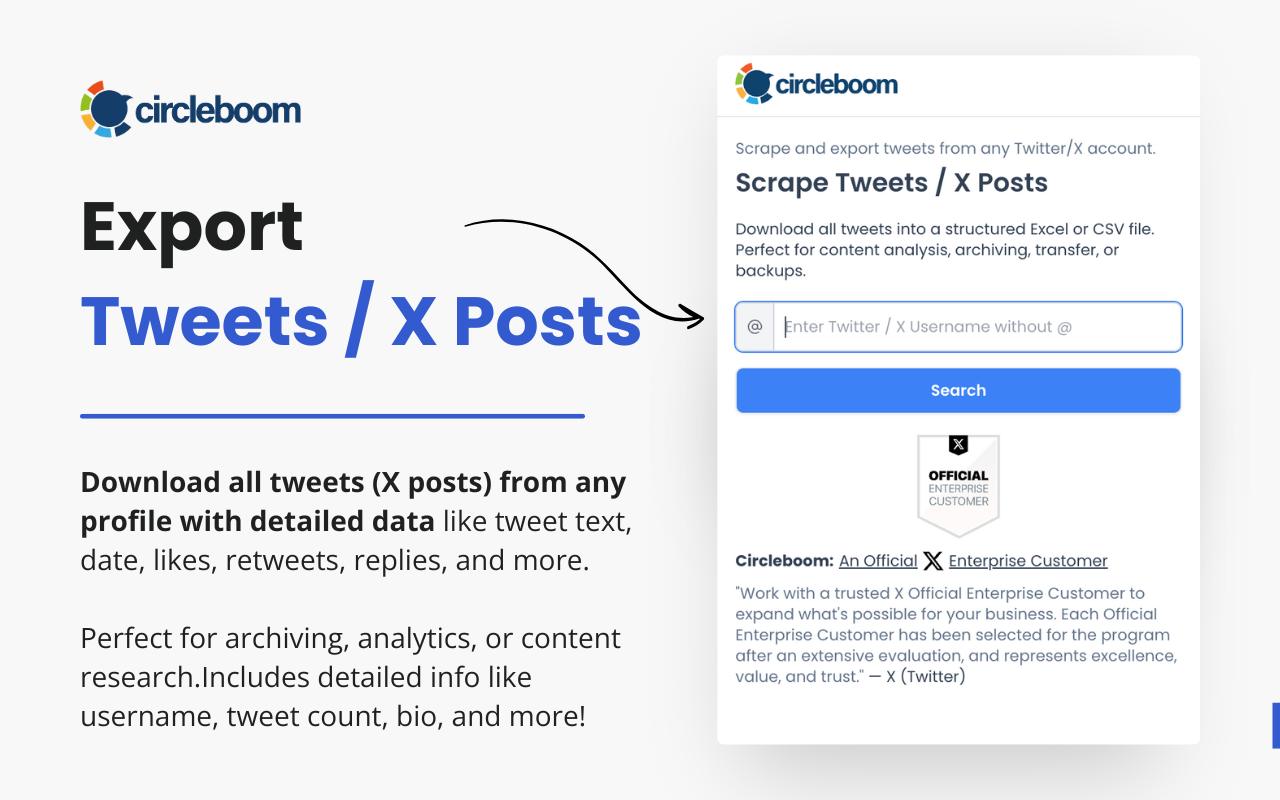
That means it doesn’t hack around the interface or scrape tweets — it works directly with Twitter’s API, which is safer and much more reliable.
Why it stands out:
- You can export tweets from any account — your own or any public user.
- The export isn’t just raw text. It comes enriched with useful metadata:
- Tweet text and ID
- Date and time posted
- Engagement metrics (likes, retweets, replies, views if available)
- Links to images or videos in the tweet
- Hashtags, language, and sometimes location info
Step-by-step: How to export following with Circleboom
Follow these steps and find out how to export Twitter following list with Circleboom's Chrome Extension:
Step #1 — Enter the username
Type the @username of the account whose data you want (e.g., @elonmusk) into the search box and click Search.
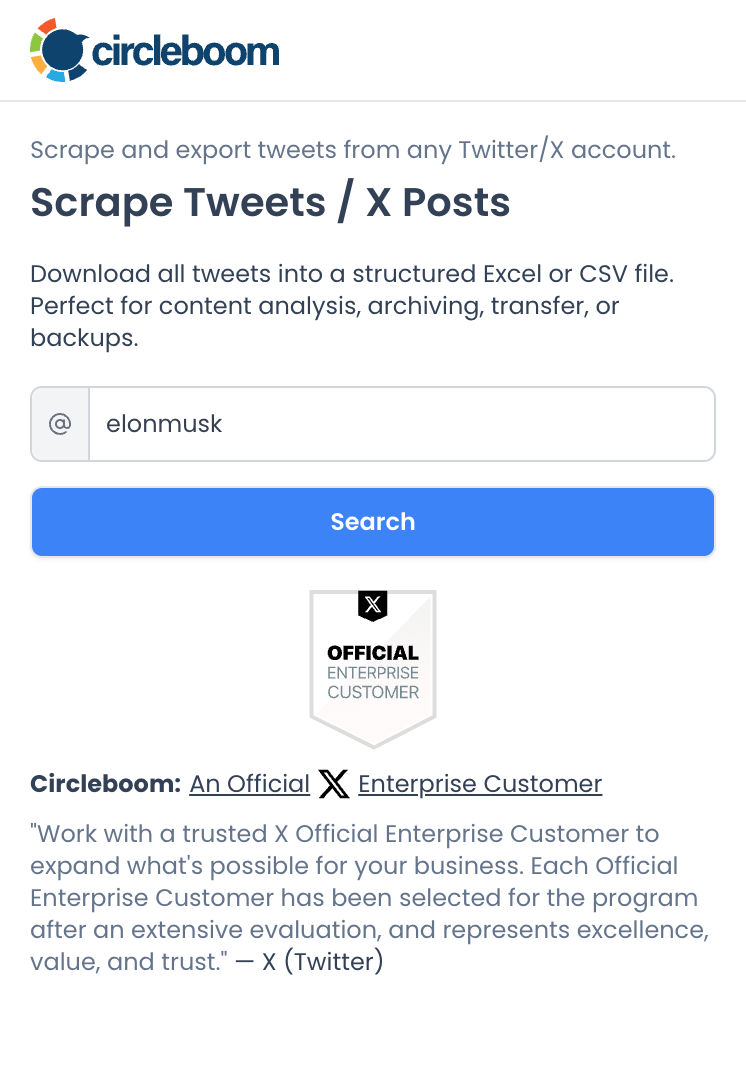
Step #2 — Choose what to export
On the profile screen, pick one of:
- Export Twitter / X Following (to get the accounts they follow)
- Export Twitter / X Followers (to get who follows them)
- Export Tweets / X Posts (to get their posts)
Select the option you want and click Next.
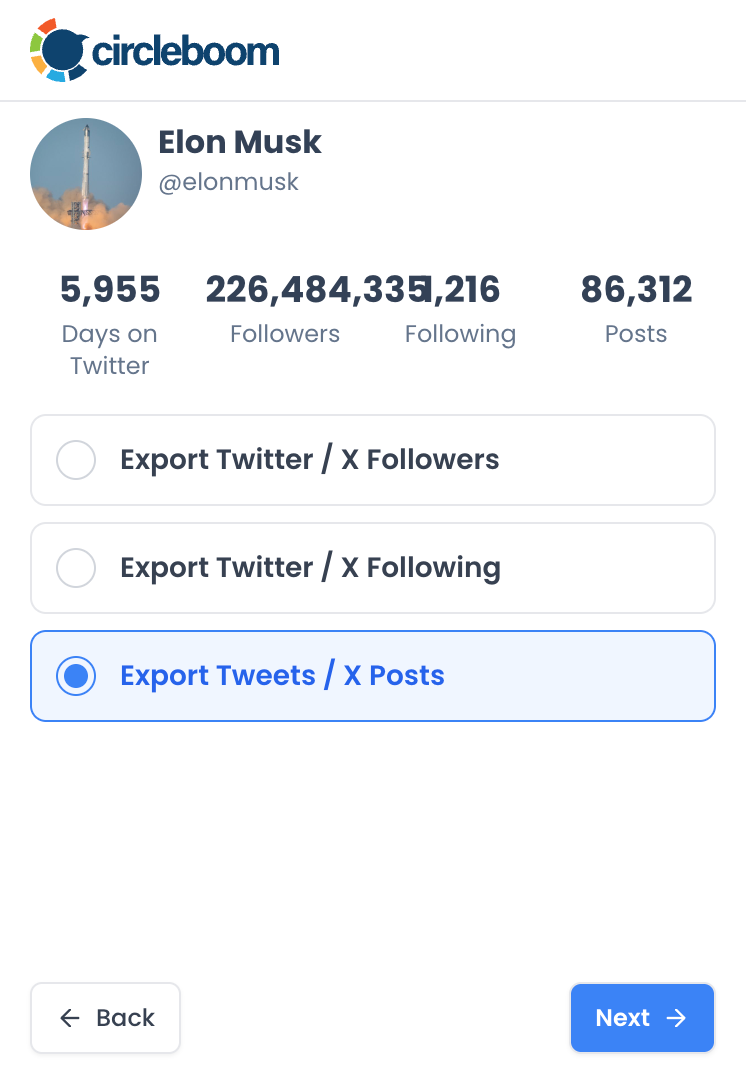
Step #3 — Enter your email
Type the email address where you’d like to receive the file, then click Next.
Recommendation: Sign in or create a Circleboom account so your export is also saved to your dashboard for easy access later.

Step #4 — Get your CSV
Circleboom prepares a clean CSV file of your selection and emails it to you. You can also download it anytime from your Circleboom account.
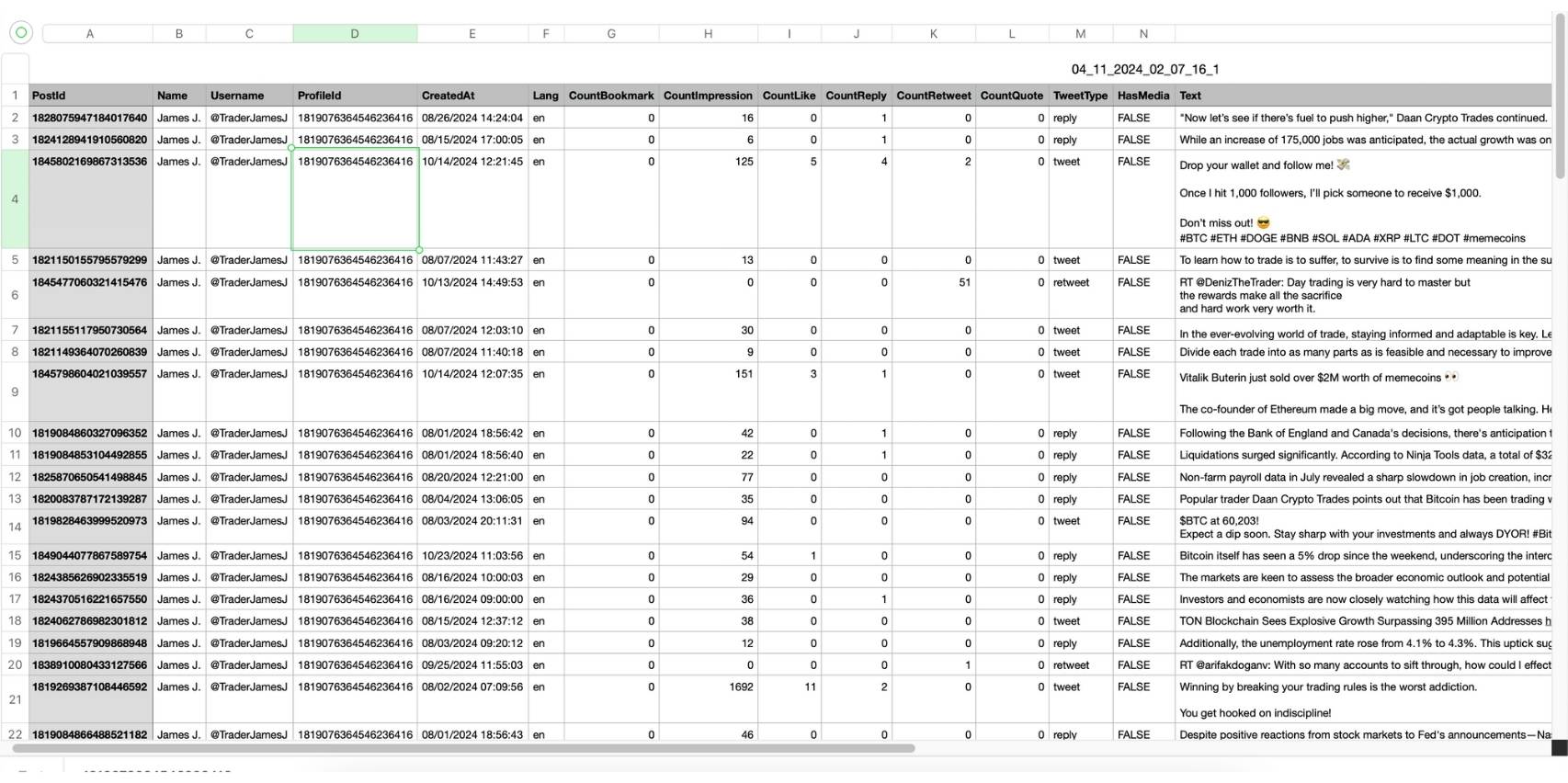
How I used it:
I exported Elon Musk's tweets to look at engagement patterns. Circleboom’s CSV file made it easy to sort by likes and retweets and find specific tweets with a keyword.
I quickly noticed that tweets mentioning Dogecoin almost always led to immediate spikes in Dogecoin’s price, sometimes within minutes. Here are the details of my analysis:

2. TwExport
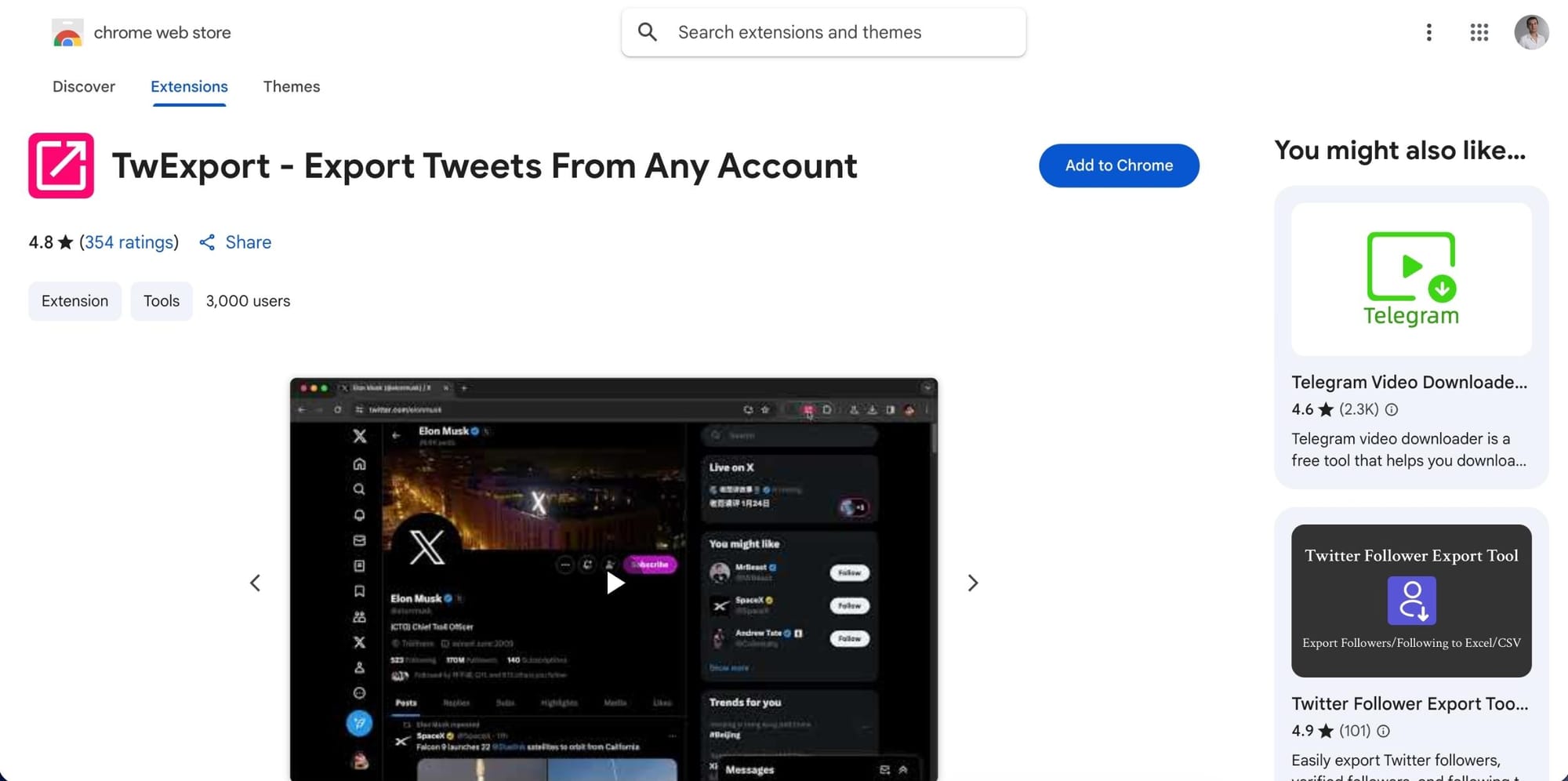
⭐ Rating: 4.8
Features: A Chrome extension that exports tweets from any public account into CSV. It includes tweet text, date, links, engagement counts, and media URLs.
Best for: Quick competitor research. Many marketers use it to pull tweet sets for hashtag and engagement analysis.
Limitations:
- Scraping-based → can break when Twitter updates its UI.
- Large exports (over ~2,000 tweets) may freeze or miss rows.
- Requires broad browser permissions.
3. TwExportly
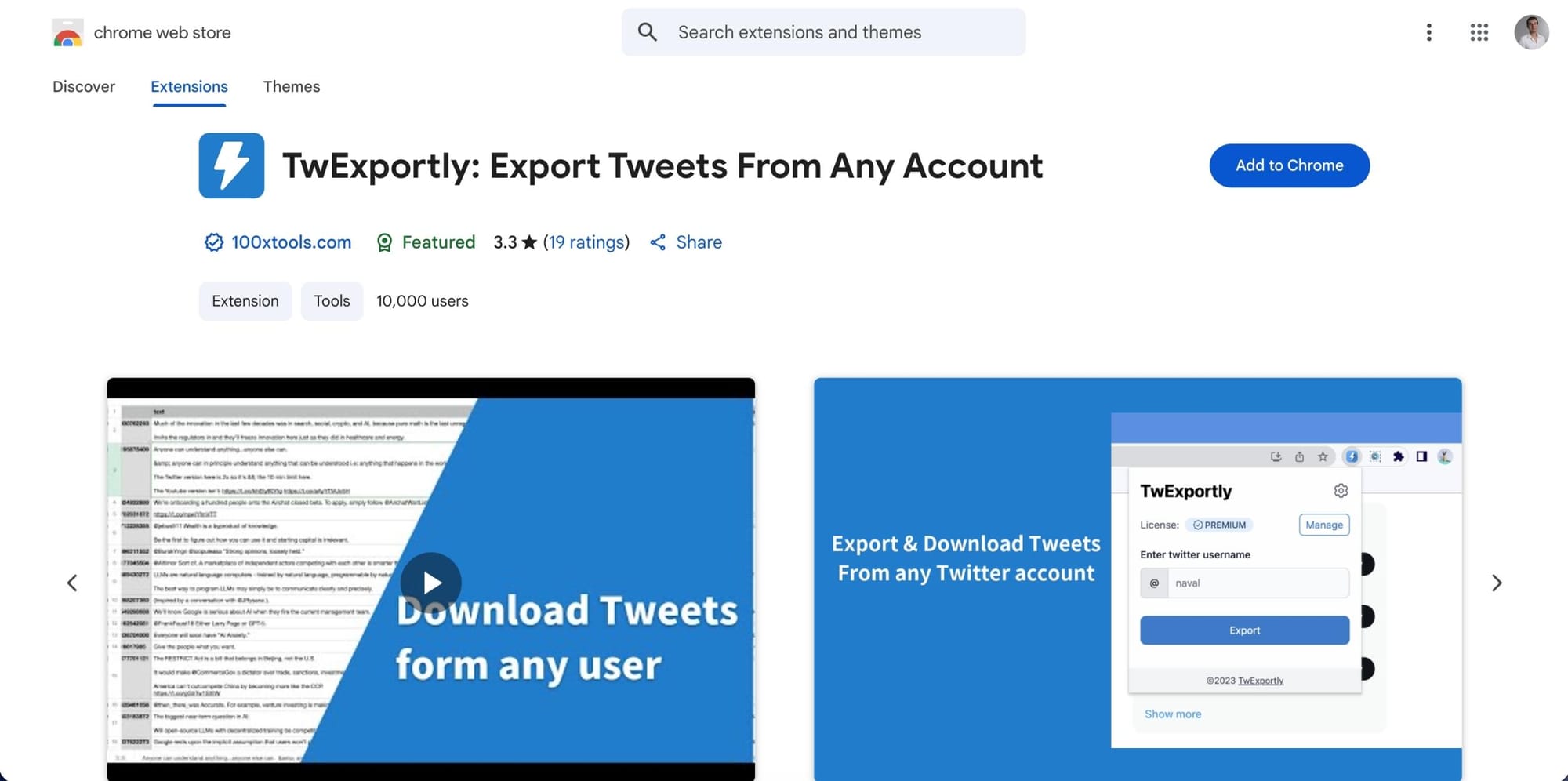
⭐ Rating: 3.3
Features: Chrome extension with date filters. Lets you export only tweets from a specific year, quarter, or campaign period. Output available in CSV or Excel.
Best for: Researchers who don’t need everything, just a specific slice (e.g., all tweets from Jan–Mar 2024).
Limitations:
- Limited engagement data (often just text + dates).
- Free version is capped; full version behind a paywall.
- Not stable for accounts with thousands of tweets.
4. TwExtract
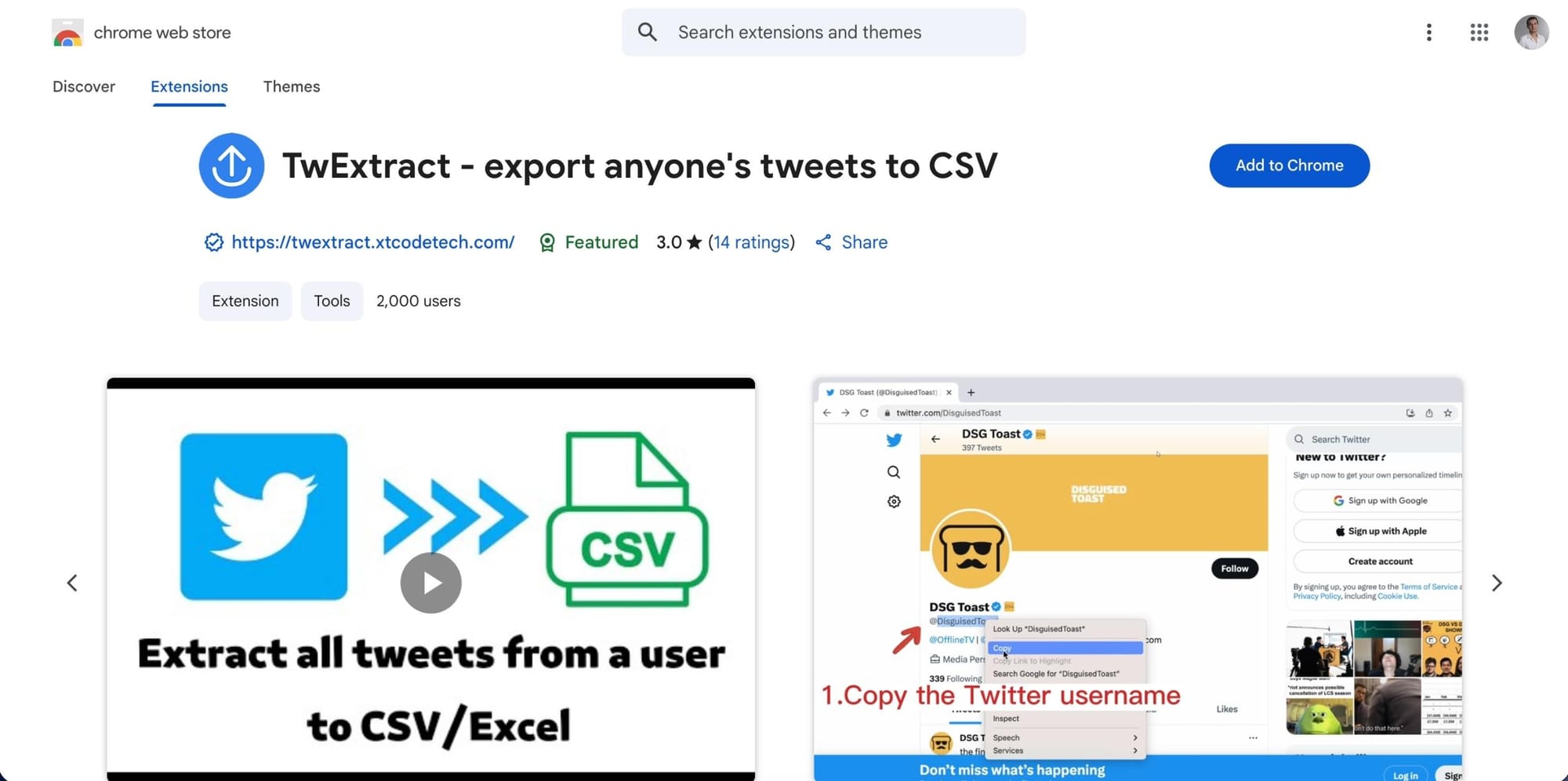
⭐ Rating: 3.0
Features: Captures tweets with replies and engagement counts. Also extracts media URLs (images, GIFs, videos).
Best for: Deeper analysis projects where context matters—like mapping an influencer’s interactions in addition to their original posts.
Limitations:
- Struggles with very large exports (>1,000 tweets).
- CSV may require manual cleanup (media links sometimes messy).
5. PandaExtract
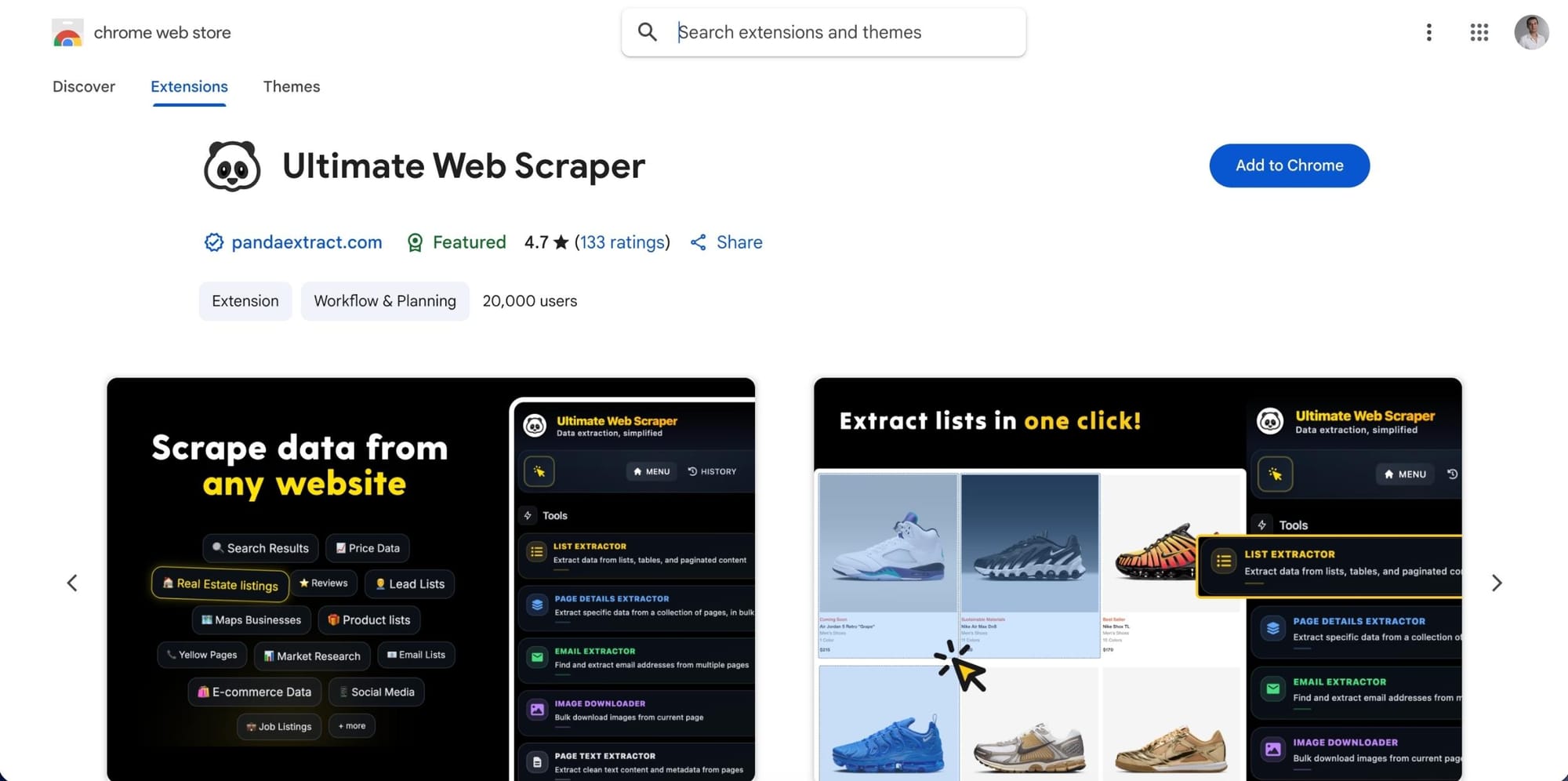
⭐ Rating: 4.7
Features: General-purpose scraper that can be configured for tweets. You select elements on the page (profile, hashtag search, etc.), and it exports them into CSV, Excel, or JSON.
Best for: Flexible, niche tasks like:
- Export all tweets mentioning a keyword.
- Grab tweets from search results instead of just profiles.
- Save only tweets with media.
Limitations:
- Manual → requires scrolling to load content.
- Less stable on large accounts (5,000+ tweets).
- Needs higher permissions since it scrapes directly from the page.
Best Practices & Tips for Exporting (Extended Guide)
Exporting tweets is more than just clicking “download.” If you want clean, reliable, and usable data, here’s a deeper set of tips that I’ve learned:
1. Define Your Goal First
Ask yourself: why am I exporting?
- If it’s for a content audit, you’ll want engagement stats and dates.
- For competitor research, you may want replies and media.
- For backup, text-only might be fine.
Knowing your goal will guide which tool you choose.
2. Use Filters Whenever Possible
Don’t waste time exporting everything. Narrow your export by:
- Date range (e.g., only last year’s tweets).
- Keywords or hashtags (e.g., only tweets mentioning “crypto”).
- Media type (e.g., just tweets with images).
Filtered exports = smaller, cleaner datasets that are easier to work with.
3. Break Large Exports into Chunks
Twitter limits API exports to ~3,200 tweets. Scraping tools struggle with large histories too. If you need more, split your exports by year or quarter. Example: export 2019 tweets separately from 2020 tweets.
4. Clean Your Data After Export
Raw CSV files are rarely perfect. Always:
- Remove duplicates.
- Standardize date formats.
- Create new columns (e.g., “Engagement Rate = Likes + Retweets ÷ Followers”).
- Tag tweets by type (thread, single post, media) for deeper analysis.
5. Save Backups in Multiple Places
Always keep at least two copies: one on your local computer and one in cloud storage (Google Drive, Dropbox, etc.). If you’re doing research or client work, version your exports (e.g., “ClientX_Tweets_Jan2025.csv”).
6. Check What Data is Missing
Some tools only export text. Others add engagement counts, media, hashtags, or even language. Before exporting, double-check what fields you need. For instance: Circleboom gave me tweet dates and engagement counts, but a scraping tool I tried only gave raw text.
7. Stay Ethical & Compliant
Stick to public data. Exporting your competitors’ tweets for analysis is fine (they’re public), but exporting private or sensitive information is not. Don’t overuse scraping tools in ways that might get your account flagged.
8. Keep It Ongoing
An export is just a snapshot. If you want to see trends, schedule exports regularly — monthly or quarterly. This helps you monitor changes in your own content or a competitor’s strategy over time.
9. Test Before Committing
Before pulling 3,000 tweets, try exporting 50–100. This lets you preview the output format, check if the data is complete, and avoid wasting time.
Final Thoughts
Exporting tweets can transform your content history from a black box into a playbook for future growth.
- If you want safe, enriched, and professional-grade exports → Circleboom is the clear winner.

- If you’re okay with experimenting, tools like TwExport, TwExportly, TwExtract, and PandaExtract have their uses, but come with risks and limits.
👉 Whether you’re auditing your own history, analyzing competitors, or just archiving content, exporting tweets gives you clarity and control over your presence on X.









